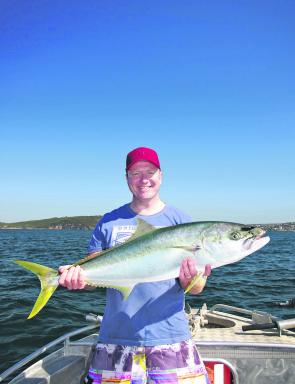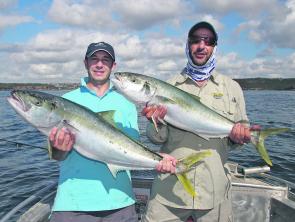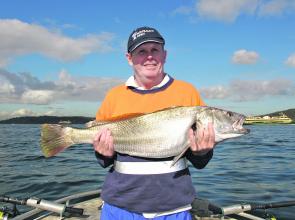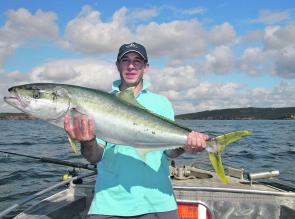It hasn’t been a great season for kingfish from a numbers perspective but for the trophy hunters, it’s been a pearler.
The big fellas like the deeper spots like North Head and South Head, Watsons Bay, Neilson Park, Clifton Gardens and some Middle Harbour spots.
They also like the tides with a bit of run in them.
Watch your tide chart for periods of big variation between high and low. A big high doesn’t necessarily equate to a lot of run if the low is a high low.
New and full moons tend to produce the best tides.
Best baits are fresh squid and cuttlefish. The guts of a big squid are the NO 1 bait and will often outfish a live squid.
April starts the tail end of the mulloway season. We get two peak bites in the Harbour, mid-October to mid-December and again from April to July.
The early season is characterised by lots of 3kg-10kg school fish that congregate in the lower reaches around the hard reef and sand bottom.
The late season fish tend to be bigger but not in the same numbers, and are found farther upstream on a mud bottom. Every now and again, in the really wet years (like now!), they become fairly prolific right through the season.
Jewies specialise in hunting in dirty and dark water so a big flush of dirty water from the rivers gets them fired up along the coast.
We have a great run of fish now on the close reefs, beaches and lower harbours and estuaries.
Veteran northern beaches jewie fisherman Pete Johnson, warned me to get ready for a big run this year and he wasn’t mistaken.
Mulloway have adapted very well to the human-made structures in the Harbour. When they are not feeding they love shade and breaks in the current, so the likes of deep-water jetties, marinas, wrecks and bridges provide ideal holding grounds.
The down side is that they are more sensitive to noise and commotion than some other common big predators, so keep your approach as quiet as possible.
They are probably the hardest of all fish to crack the code for consistent success.
Best bites at this time of year will occur when the wind is blowing north-west and then swinging to south-west or south – just before a cold front. It’s a narrow window of opportunity.
It doesn’t seem to matter too much whether it’s overcast or bright and sunny. Of course, this is not the only time they feed, it’s just the best.
The turn of the high tide and the first 90 minutes of ebb is the prime time. The next-best is the turn of the low and the first 90 minutes of run in. The times of minimal tidal flow reflect the mulloway’s lazy nature.
Their holding grounds might be some distance from their feeding grounds.
Imagine a wreck on barren sand or mud bottom in the harbour, where jew hold out of the strong run.
On the turn of the tide they come out of cover and head to food-rich kelp beds or rock walls to feed.
Being in the vicinity of holding structure gives your best shot at these fish. They encounter your offerings as they make their way out to the feeding grounds and again as head back.
Obviously, they will be hungrier on their way out than when they return after a feed so right on the turn of the high or low, when they first make their move out is the ultimate time to be near holding cover.
You will catch good jew during the day if all conditions are right.
Divers tell me mulloway hang in and around wrecks, caves, ledges, pylons and marinas and under coastal rock shelves in very shallow, sudsy water.
They are different from kings, which hang around structure for reference, food and shade.
Jewies actually like to get inside the structure for security. This doesn’t mean that they ambush feed from there. They feed when they move out onto richer grounds.
The worst mulloway week is the week after and including the night of the full moon. The best weeks are the lead-up to the full and new moon – perfect tides during these periods fall early morning and late afternoon.
If you want to catch quality Harbour jew consistently you are going to have to master squid fishing. Squid are the top bait and the squid has to be back in the water as bait a maximum of six hours after it was caught, not bought.
Other good baits include large live tailor and mullet but you will need to come up with a good method of controlling them or you can end up in an awful tangle, especially at night.
Big fillets of these mentioned fish (leave the head on one side and the tail on the other) are also good.
Most of the bigger jewies and kings that I catch have silver biddies in their gut so if you can find a way to catch them, they are great, too.
When the fish takes the bait hit it immediately, don’t let it run.
Reads: 1310
There mightn’t have been quite so many kings in the Harbour this season but the trophy fish are certainly there.

Head to deeper spots in the Harbour to encounter quality kingies like these.

Bigger mulloway are on the cards from this month until July almost anywhere in the Harbour.

The bream gear just won’t cut it on kings like this.




